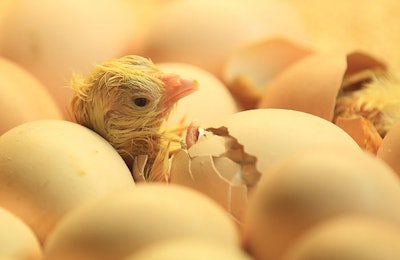
Sarah Goldberg, director of communications and legislative affairs at the Foundation for Food and Agriculture Research (FFAR) announced the six Phase I award winners of the Egg-Tech Prize at the Poultry Tech Summit, held November 20-22, 2019, at the Georgia Tech Hotel & Conference Center in Atlanta, Georgia.
“We thought we knew what was possible, but we were blown away by the depth and creativity of the submissions for the Phase I Egg-Tech Prize,” Goldberg said.
The sex of most chicks is identified after hatching. As a result, approximately 6 billion to 7 billion male layer chicks are culled each year. Producers spend more than $70 million in labor and energy to incubate and sex these eggs and the value of wasted eggs in the U.S. is more than $440 million annually.

The value of wasted eggs in the U.S. is more than $440 million annually. This prize money is intended to fund research that will help eliminate the approximately 6 billion to 7 billion male layer chicks culled each year. (ziquiu | iStockPhoto.com)
FFAR and Open Philanthropy joined forces to offer up to $6 million in grants and prizes to the firm, group or individual that successfully develops technology that can accurately and rapidly determine a chick’s sex as early as possible during the egg production process.
Six Phase I winners will receive seed funding to move their ideas from concept into design. The prize winners came from diverse scientific and technological backgrounds; everything from computer science to chemistry was represented in the quest to accurately predict the sex of eggs in a timely manner.
Accelerated MRI technology
Magnetic resonance imaging (MRI) scans are typically used to create detailed images of organs and tissues in the body. The team at Orbem.ai, led by co-founder Pedro Gomez, believe they can use accelerated MRI technology to automatically scan and classify eggs without penetrating the shell.
The MRI approach allows users to examine organ development to detect physical differences between male and female embryos. Artificial intelligence then classifies the eggs by sex.
“We are working on a prototype where you place a tray of eggs into a modified MRI machine,” Gomez said. “During the first phase of this prize, we focused on the accuracy of identifying the different sexes. In the protype phase, we are focusing on creating a specialized MRI coil that scans eggs quickly.”
Orbem.ai was awarded $400,000 by FFAR, which was matched by outside contributors for a total of $1,149,911.
“Winning this award was a sign of validation that we are on the right track towards solving this problem. We are super excited to be working on this technology,” Gomez said.
Optics and multidimensional spectral mapping
John Humphrey, the founder of Microscale Devices LLC, and his team are working to develop optical fingerprints that can determine the sex of an egg is less than five seconds. The technology uses multidimensional spectral mapping, which measures the refracted light patterns of different wavelengths that are directed at an egg.
“Our decade-long experience in the poultry industry has allowed us to come up with unique systems and processes that are reproducible and scalable. We use a unique variety of algorithms and optical systems which allow us to streamline the process,” Humphrey said. “This award helps support our goals to further develop processes that provide the scale and quality required by poultry producers.”
Microscale Devices received $251,459 from FFAR and Open Philanthropy. The funding was matched by outside contributors to total $451,459.
Volatile organic compounds
Four of the Phase I winning teams are working on methodologies involving volatile organic compounds (VOCs), naturally occurring chemicals found in all living organisms.
Adam Rivers, an analytical chemist with the United States Department of Agriculture Agricultural Research Service, was awarded $396,762. His research uses a combination of fiber optics and machine learning to analyze VOCs in eggs. The technique also involves an analytical chemistry technique, proton transfer reaction mass spectrometry (PTR-MS), to detect and analyze the composition of VOCs at a rate of 2,000 samples per hour.
“We really see our role as the development of the platform technology that integrators can add to existing commercial egg handling equipment in their production line,” Rivers said.
Abdennour Abbas, an associate professor in the department of bioproducts and biosystems engineering at the University of Minnesota, has developed a two-pronged method to determine the sex of an egg. First, a 3D scanner analyzes the geometric shape of eggs. With the help of machine learning, researchers can recognize egg sex based on geometric parameters. Next, he uses PTR-MS to measure the VOCs. Abbas received $400,000 to develop the artificial intelligence program.
Jeroen Lammertyn of KU Leuven is working on a non-invasive technique that would register VOCs as they pass through an eggshell during incubation. Specialized sensor technology, gas chromatography mass spectrometry (GC-MS) and selected ion flow tube mass spectrometry (SIFT-MS) would be used to analyze the VOCs. Outside contributors matched the $315,370 award for a total of $650,842.
Thomas Turpen with SensIT Ventures Inc. received $400,000 for his work on the development of a microchip-based chemical sensor. The sensor is designed to detect VOCs released from individual eggs during storage and incubation. Machine learning will then sort and classify the eggs by sex.
Phase II of the Egg-Tech Prize
The next phase of the program will ask for a working prototype sex sorting system with a minimum 98% accuracy and which function on or before Day 8 of incubation. The process must not reduce the hatching rate by more than 1.5% and must have the potential to handle at least 15,000 eggs per hour.
Participation of Phase I is not necessary to apply for Phase II. FFAR will open submissions for Phase II of the Egg-Tech Prize in spring 2021.


















